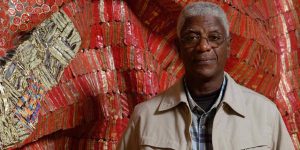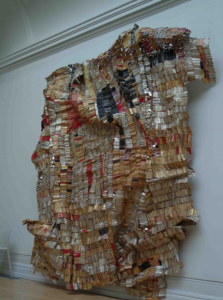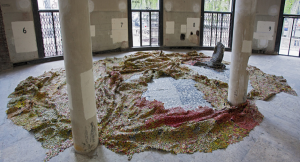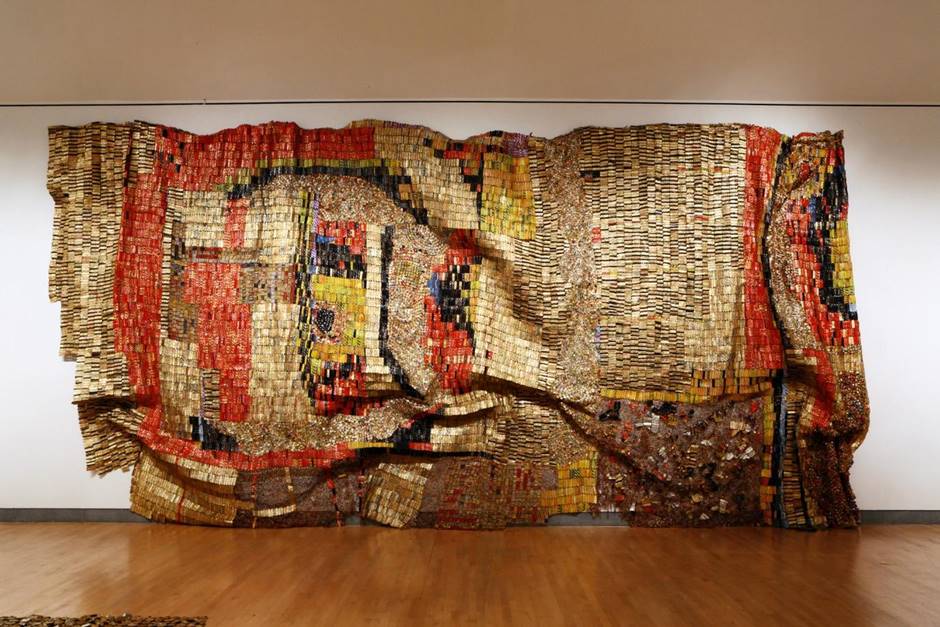Digvijay Nikam
“What I am interested in is the fact of many hands…when people see work like that, they should be able to feel the presence of those people.”
– Anatsui
El Anatsui is a Ghanian sculptor who has garnered international acclaim for his ingenious use of everyday discarded materials in his work, especially the use of

Courtesy of Andy Keate
liquor bottle caps in his “bottle-top” installations. Born in 1944, Anatsui trained at the College of Art, University of Science and Technology in Ghana and later relocated to Nigeria in 1975 and started teaching as a Professor of Sculpture at the University of Nigeria, Nsukka where he still continues to live and work after retirement. Over his extended career, Anatsui has won several accolades in the art world including the Prince Claus Award, the Praemium Imperiale, and the Golden Lion for Lifetime Achievement.
Anatsui started his career with using clay, ceramic and wooden trays found in local markets which came primarily from his attempt to indigenize his aesthetic given his dissatisfaction with the dominance of imported materials like plaster of Paris in the art schools. He later experimented with evaporated cans and Cassava graters. However, liquor bottle caps – the material that has come to define his artistic practice in the past few decades – was discovered accidentally by the sculptor in 1998 when he found a discarded bag of loose caps along the roadside.
Using thousands and thousands of flattened, folded, and crumpled pieces of muti-coloured aluminium bottle caps gathered from local alcohol recycling stations which are meticulously bound together using copper wire, Anatsui creates large scale sculptures akin to wall-hangings that have richly textured metallic surface which when hung on a wall registers folds and drapes reminiscent of textile. Many of his works, like Man’s Cloth (2002) and Trova (2016) have drawn resemblances to the Ghanian Kente cloth which has often led to him being termed a neo-traditionalist in Africa – a categorisation that he dismisses, asking us to consider his works as sculptures despite their cloth like look.
For Anatsui, giving context to a work confines it and hence, central to his works is the idea of ‘open-endedness’ which not only includes inviting multiple interpretations of the work but, interestingly, also involves leaving the sculpture’s final form to the curators and collectors who give the sculpture, every time, a new form in their installations. Hence, no body sees the same Anatsui twice.

Courtesy- El Anatsui.
This open-endedness is exhibited in the simultaneously local and global as well as historical and contemporary concerns of his work. An apt example of this is his Old Man’s Cloth (2003). The enchanting display of its shimmering surface and large scale suggests opulence, power, and royalty. Yet, through the liquor bottle caps, he investigates and presents the unpleasant history of trade between Africa and Europe, since as he explains, “Alcohol was one of the commodities brought with [Europeans] to exchange for goods in Africa. Eventually alcohol became one of the items used in the transatlantic slave trade. They made rum in the West Indies, took it to Liverpool, and then it made its way back to Africa. I thought that the bottle caps had a strong reference to the history of Africa.” At the same time the work using ‘leftovers’ of bought goods draws our attention to the global issues of consumerism, environment, and waste troubling our contemporary lives.
Another of his works that points to this environmental urgency is Tiled Flower Garden (2012). A vast ground-floor installation of vibrant colours and ghastly form, this work resembles, as one observer remarks, “a polluted wave engulfing the earth below it” and in doing that it makes a dramatic statement on the crumbling ecology of our world and the environmental legacy of colonialism.

Apart from their artistic significance, Anatsui’s works have immensely benefited the local community in Nsukka, Nigeria by generating employment opportunities and a hands-on learning atmosphere for the younger generation. He recruits hundreds of temporary workers – who consist of rural women who work at home, students or teachers – to complete his installations, often giving them salaries more than their yearly incomes. On the other hand, the obvious ecological benefits of his recycling and reusing of waste materials become more pronounced when we acknowledge the scale of his work.
El Anatsui visibilizes the various socio-economic and political forces informing the invisible mundane material reality of our everyday lives and in doing that elevates the ordinary into the exceptional. Objects, whether ordinary or not, for him are ‘living matter’ carrying traces of humanly touch and that is what gives his work – to use his own phrase – a “spiritual charge” that he finds lacking in, for instance, canvas and oil. A pioneer in sculptural practice, Anatsui’s flexible, painterly and curatorial dependent works have come to challenge and stretch the limits of thinking about sculpture as something rigid and completely independent.
His work is currently being exhibited at The Bunker Artspace, West Palm Beach, Florida alongside works of artists like Simone Leigh, Ebony Patterson and Miriam Shapiro.
References
- https://www.widewalls.ch/artists/el-anatsui
- https://www.khanacademy.org/humanities/ap-art-history/global-contemporary-apah/21st-century-apah/a/el-anatsui-old-mans-cloth
- 3. https://africanah.org/el-anatsui-3/
- https://www.newyorker.com/magazine/2021/01/18/how-el-anatsui-broke-the-seal-on-contemporary-art
- https://elanatsui.art/biography





